CHEVROLET EXPRESS 1996 1.G Owners Manual
Manufacturer: CHEVROLET, Model Year: 1996, Model line: EXPRESS, Model: CHEVROLET EXPRESS 1996 1.GPages: 376, PDF Size: 18.83 MB
Page 101 of 376
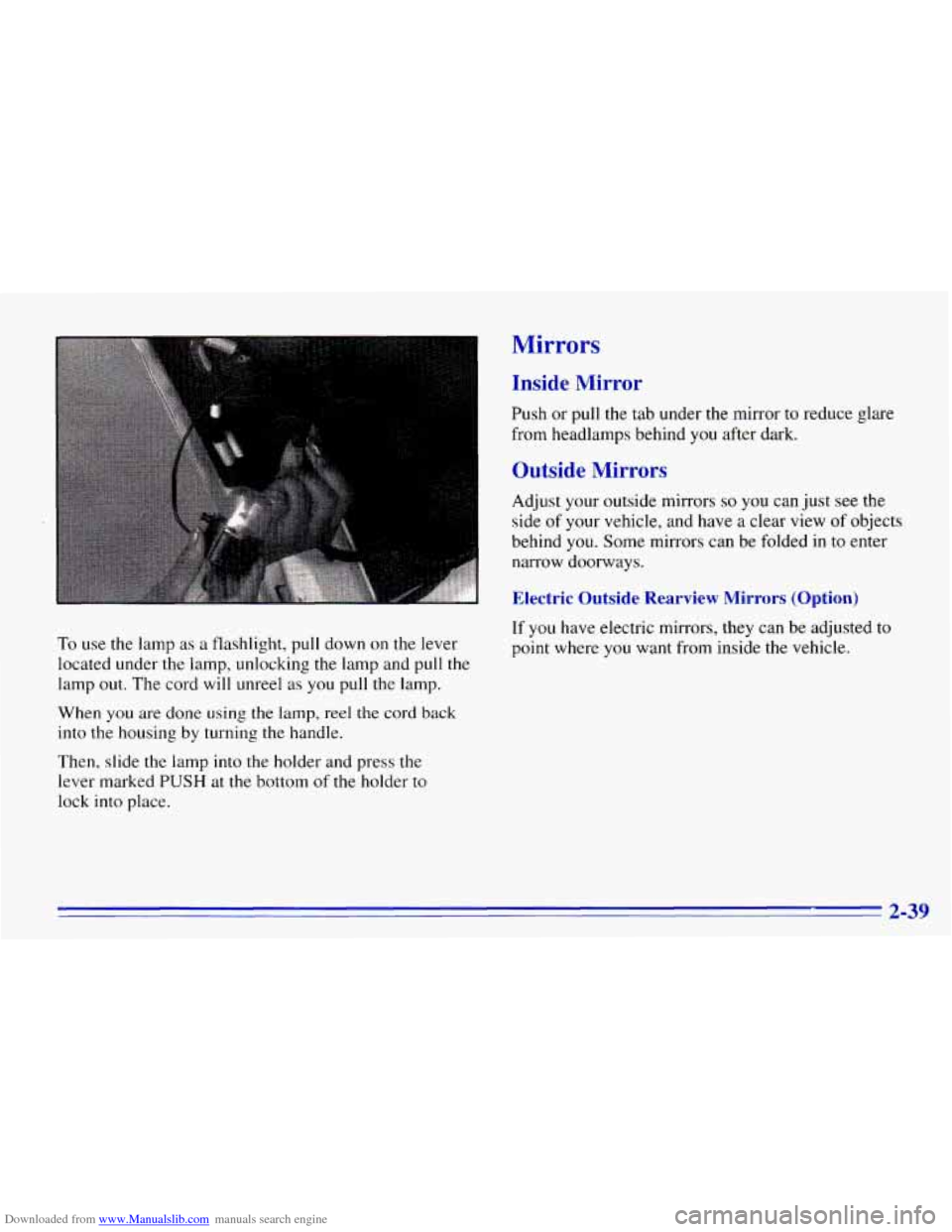
Downloaded from www.Manualslib.com manuals search engine Mirrors
Inside Mirror
Push or pull the tab under the mirror to reduce glare
from headlamps behind you after dark.
Outside Mirrors
Adjust your outside mirrors so you can just see the
side of your vehicle, and have a clear view
of objects
behind
you. Some mirrors can be folded in to enter
narrow doorways.
Electric Outside Rearview Mirrors (Option)
To use the lamp as a flashlight, pull down on the lever
located under the lamp, unlocking the lamp and pull
the
lamp out. The cord will unreel as you pull the lamp.
When
you are done using the lamp, reel the cord back
into the housing by turning the handle.
Then, slide the lamp
into the holder and press the
lever marked
PUSH at the bottom of the holder to
lock into place.
If you have electric mirrors, they can be adjusted to
point where you want from inside the vehicle.
2-39
Page 102 of 376
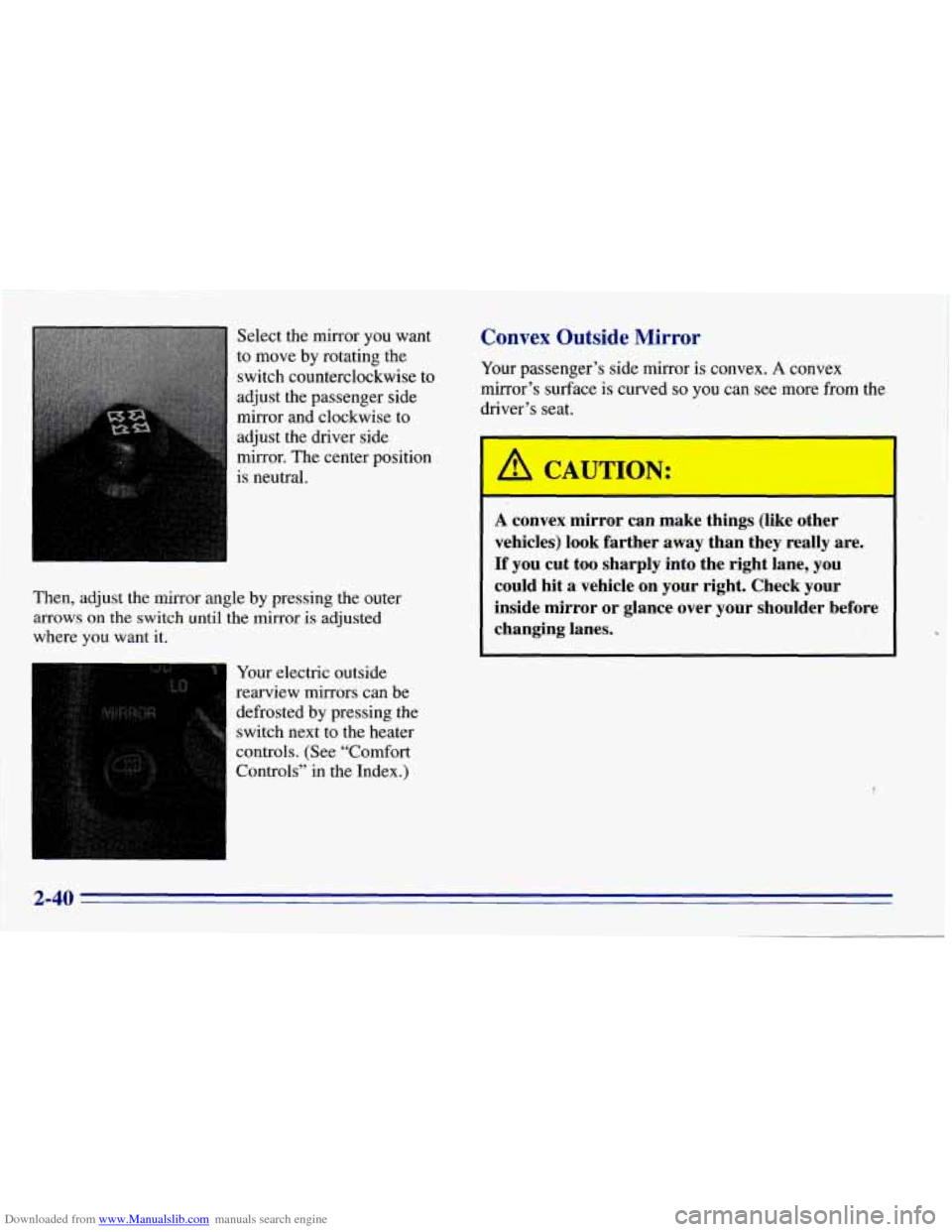
Downloaded from www.Manualslib.com manuals search engine Select the mirror you want
to move by rotating the
switch counterclockwise to
adjust the passenger side
mirror and clockwise to
adjust the driver side
mirror. The center position
is neutral.
Then, adjust the mirror angle by pressing the outer
arrows on the switch until the mirror is adjusted
where
you want it.
Your electric outside
rearview mirrors can be
defrosted by pressing the
switch next to the heater
controls. (See “Comfort
Controls” in the Index.)
Convex Outside .Mirror
Your passenger’s side mirror is convex. A convex
mirror’s surface
is curved so you can see more from the
driver’s seat.
CAUTION:
A convex mirror can make things (like other
vehicles) look farther away than they really are.
If you cut too sharply into the right lane, you
could hit a vehicle on your right. Check your
inside mirror or glance over your shoulder before
changing lanes.
I
2-40
Page 103 of 376
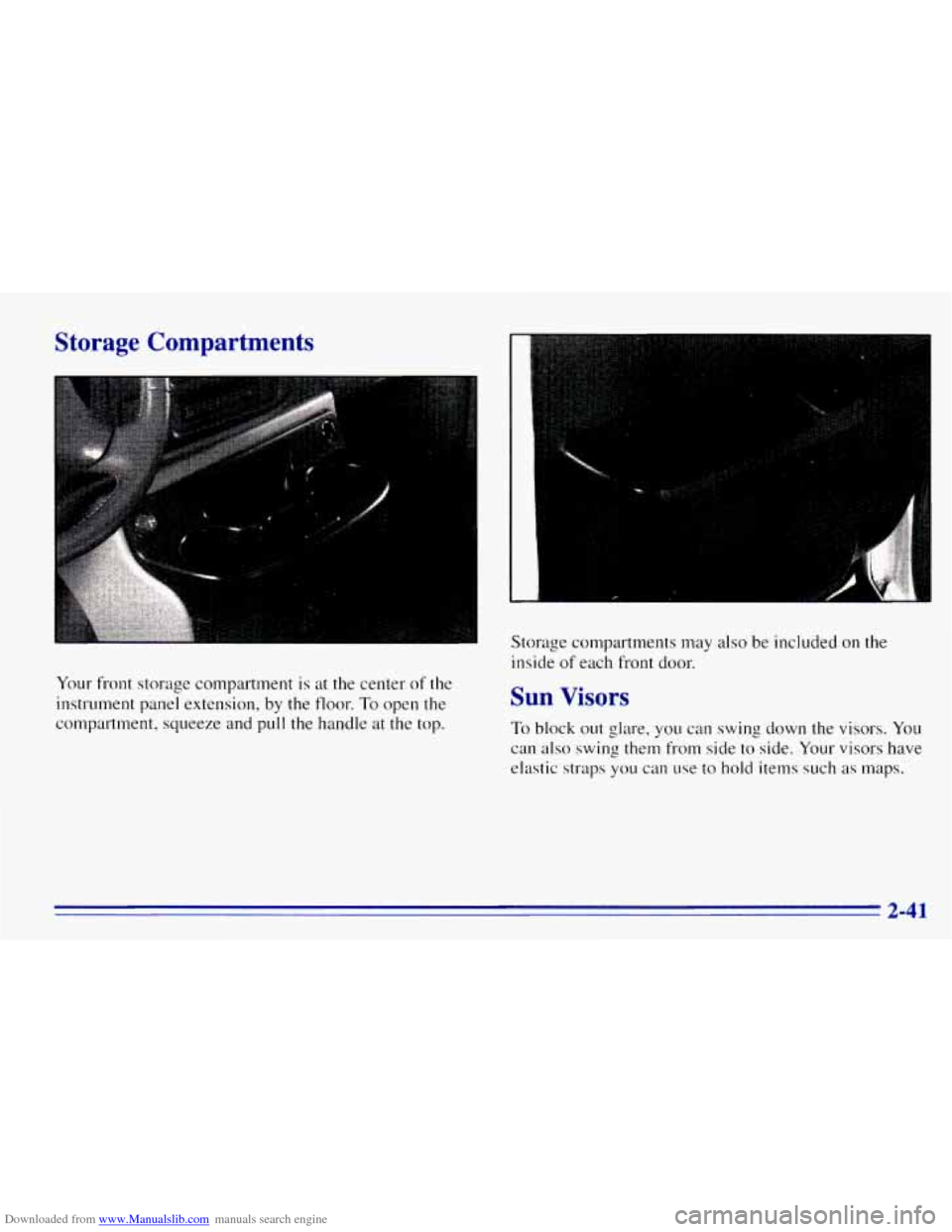
Downloaded from www.Manualslib.com manuals search engine Storage Compartments
..
Your front storage compartment is at the center of the
instrument panel extension,
by the floor. To open the
compartment, squeeze and
pull the handle at the top. Storage
compartments
may also be included on the
inside
of each front door.
Sun Visors
To block out glare, you can swing down the visors. You
can
also swing them from side to side. Your visors have
elastic straps
you can use to hold items such as maps.
2-41
Page 104 of 376
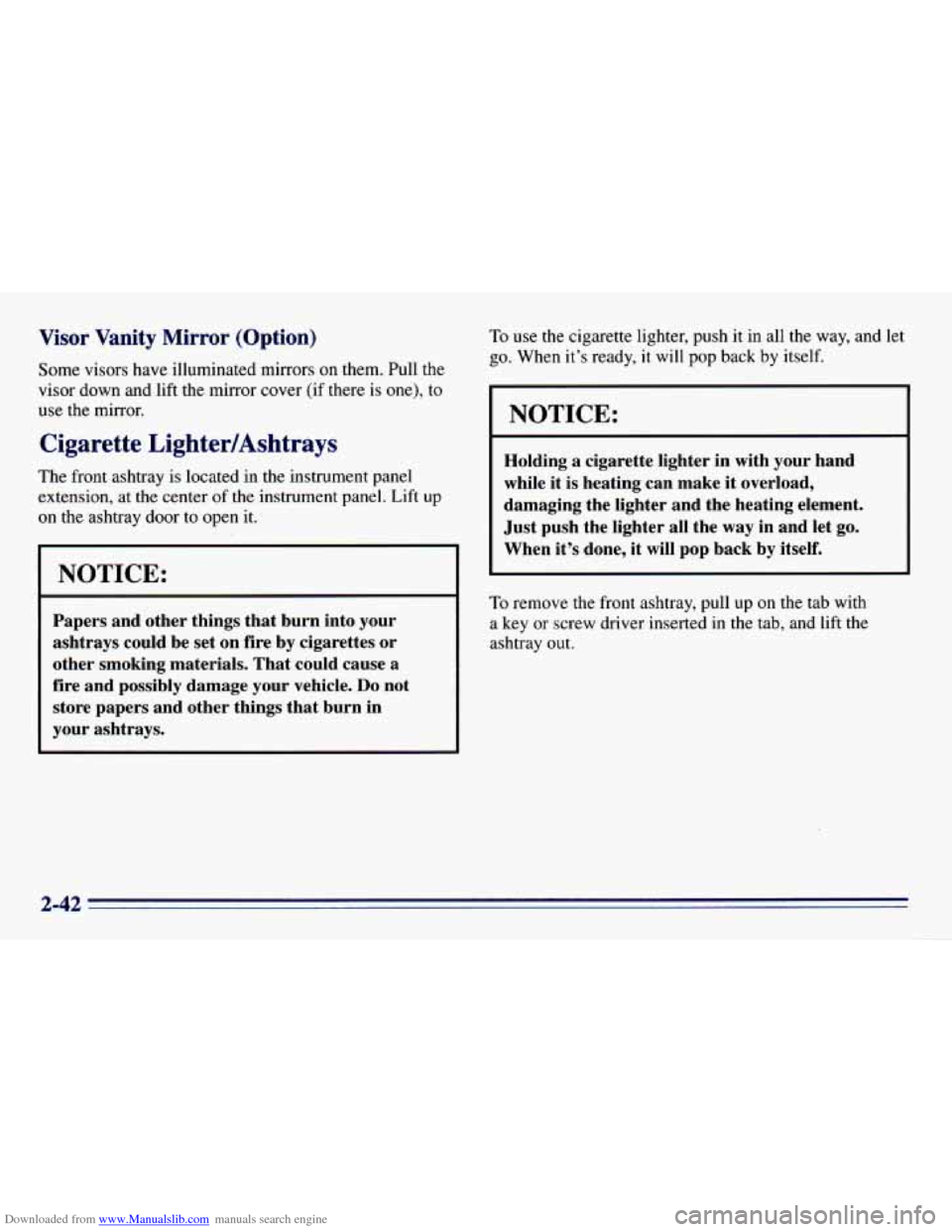
Downloaded from www.Manualslib.com manuals search engine Visor Vanity Mirror (Option)
Some visors have illuminated mirrors on them. Pull the
visor down and lift the mirror cover (if there is
one), to
use the mirror.
Cigarette LightedAshtrays
The front ashtray is located in the instrument panel
extension, at the center
of the instrument panel. Lift up
on the ashtray door to open it.
I NOTICE:
To use the cigarette lighter, push it in all the way, and let
go. When it’s ready, it will pop back by itself.
NOTICE:
Holding a cigarette lighter in with your hand
while it is heating can make
it overload,
damaging the lighter and the heating element.
Just push the lighter all the
way in and let go.
When it’s done, it will pop back by itself.
Papers and other things that burn into your
ashtrays could be set on
fire by cigarettes or
other smoking materials. That could cause a
fire and possibly damage your vehicle.
Do not
store papers and other things that burn in
your ashtrays.
To remove the front ashtray, pull up on the tab with
a
key or screw driver inserted in the tab, and lift the
ashtray out.
Page 105 of 376
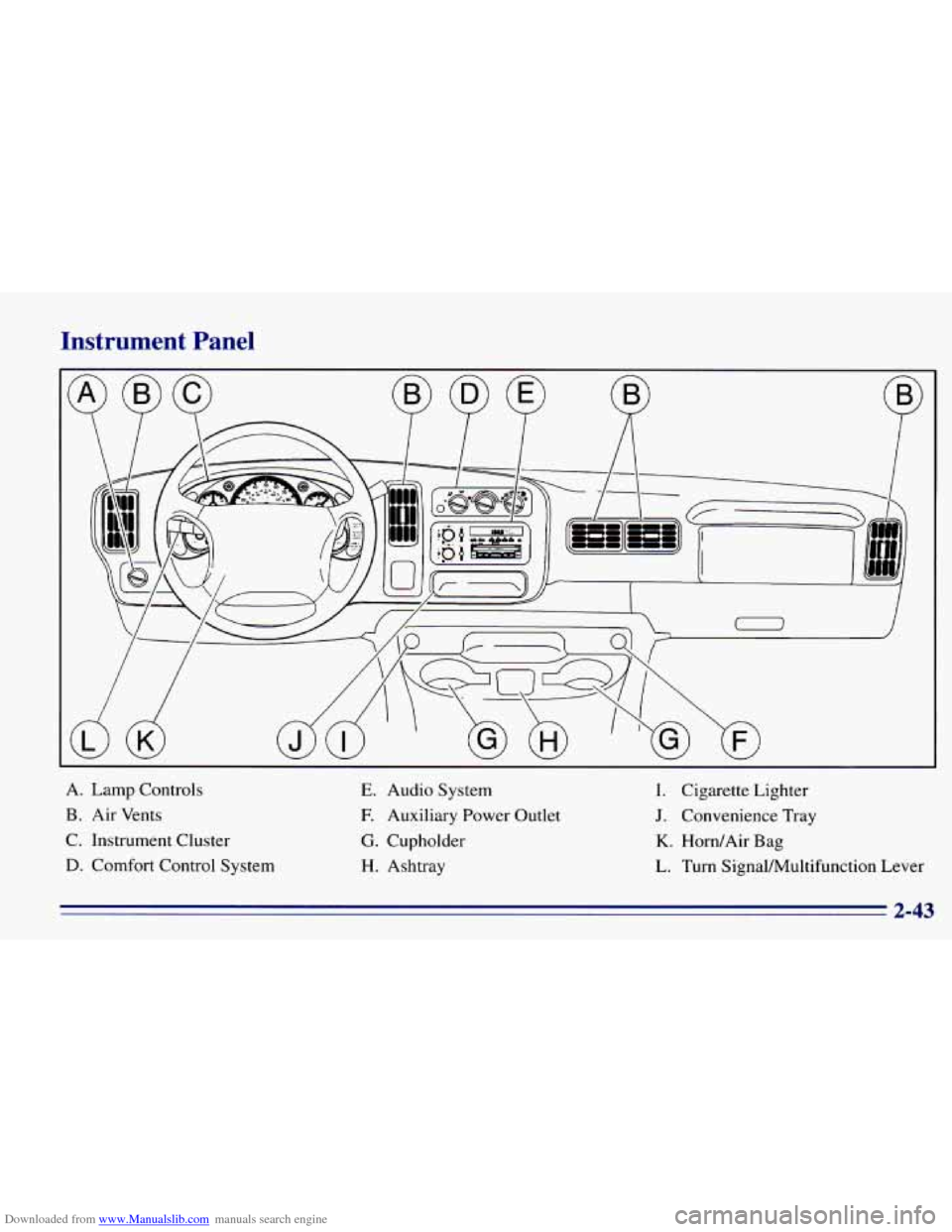
Downloaded from www.Manualslib.com manuals search engine Instrument Panel
A. Lamp Controls
B. Air Vents
C, Instrument Cluster
D. Comfort Control System
E. Audio System
E Auxiliary Power Outlet
G. Cupholder
H. Ashtray
I. Cigarette Lighter
J. Convenience Tray
K. Horn/Air Bag
L. Turn SignalAhltifunction Lever
2-43
Page 106 of 376
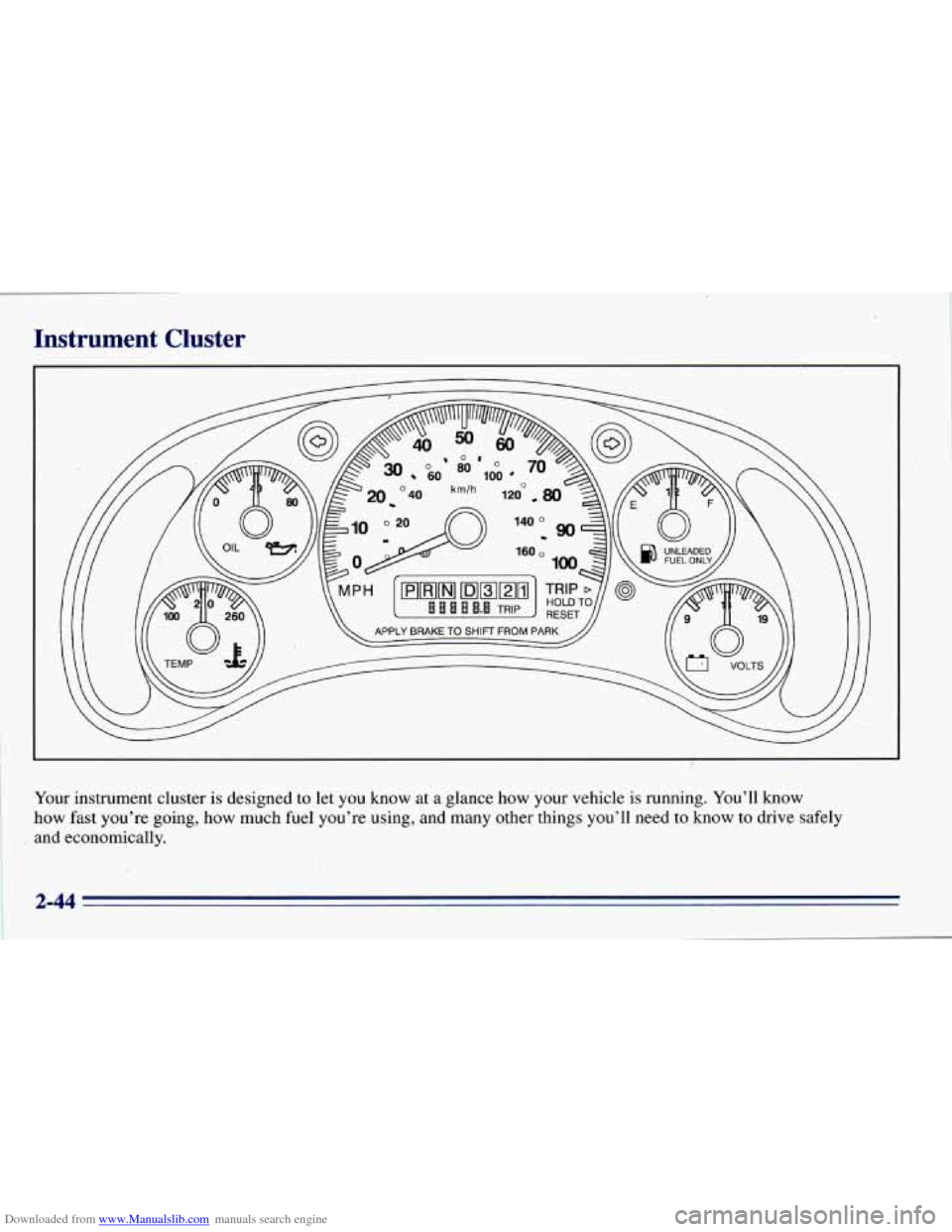
Downloaded from www.Manualslib.com manuals search engine Instrument Cluster
Your instrument cluster is designed to let you know at a glance how your vehicle is running. You’ll know
how fast you’re going, how much fuel you’re using, and many other things you’ll need
to know to drive safely
and economically.
A AA
Page 107 of 376
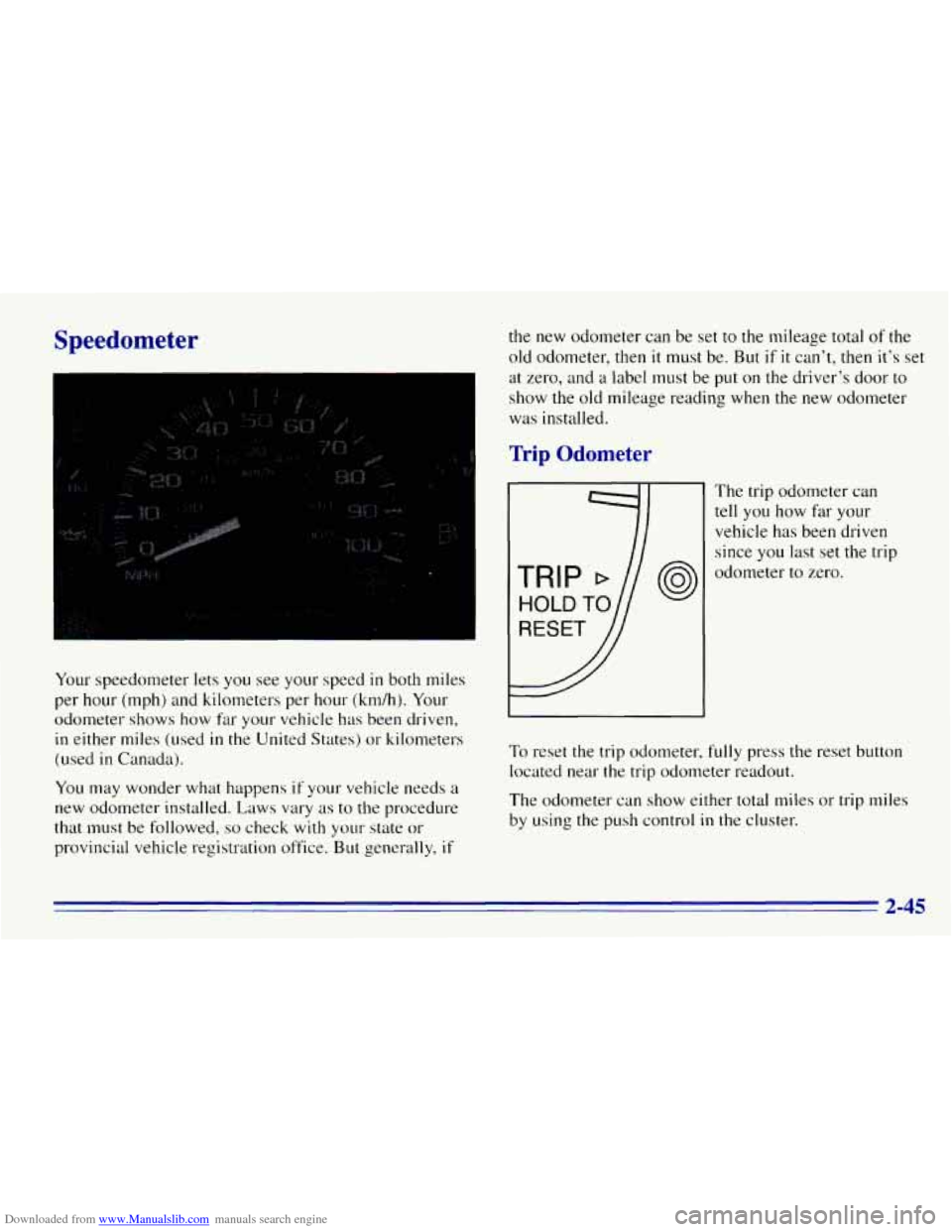
Downloaded from www.Manualslib.com manuals search engine Speedometer
Your speedometer lets you see your speed in both miles
per hour (mph) and kilometers per hour (km/h). Your
odometer shows how far your vehicle has been driven,
in either miles (used in the United States) or kilometers
(used in Canada).
You may wonder what happens if your vehicle needs a
new odometer installed. Laws vary as to the procedure
that must be followed,
so check with yo~~r state or
provincial vehicle registration office.
But generally, if
the new odometer can be set to the mileage total of the
old odometer, then
it must be. But if it can’t, then it’s set
at zero,
and a label must be put on the driver’s door to
show the old mileage reading
when the new odometer
was installed.
Trip Odometer
To reset the trip odometer, fu
The trip odometer can
tell you how fir your
vehicle has been driven
since you last set the trip
odometer to zero.
.lly press the reset
located near the trip odometer readout. button
The odometer can show either total miles or trip miles
by using the push control
in the cluster.
2-45
Page 108 of 376
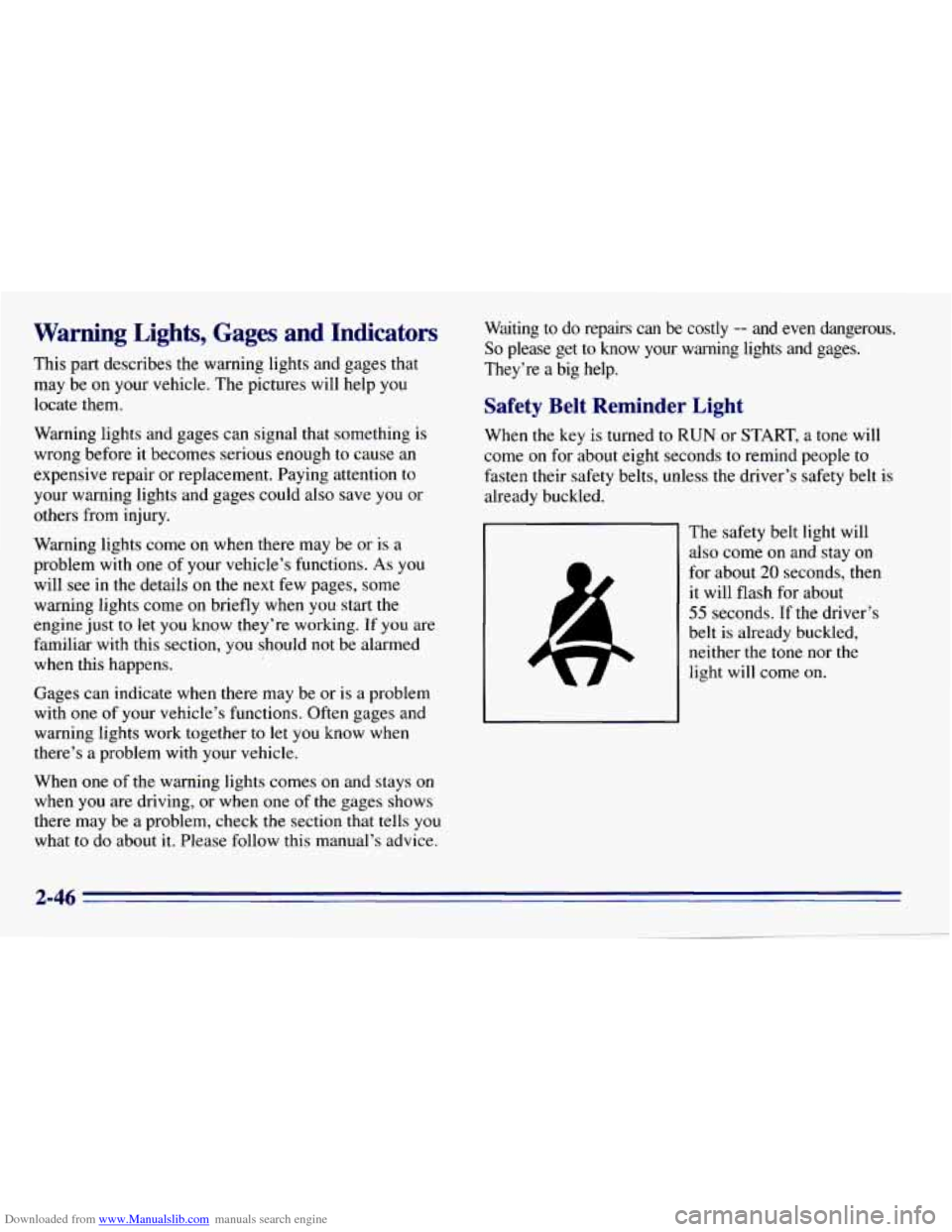
Downloaded from www.Manualslib.com manuals search engine Warning Lights, Gages and Indicators
This part describes the warning lights and gages that
may be on your vehicle. The pictures will help
you
locate them.
Warning lights and gages can signal that something
is
wrong before it becomes serious enough to cause an
expensive repair or replacement. Paying attention to
your warning lights and gages could also save
you or
others from injury.
Warning lights come on when there may be or is a
problem with one
of your vehicle’s functions. As you
will see in the details on the next few pages, some
warning lights come on briefly when
you start the
engine just to let
you know they’re working. If you are
familiar with this section,
you should not be alarmed
when this happens.
Gages can indicate when there may be or is a problem
with one
of your vehicle’s functions. Often gages and
warning lights work together
to let you know when
there’s a problem with your vehicle.
When one of the warning lights comes
on and stays on
when
you are driving, or when one of the gages shows
there may
be a problem, check the section that tells you
what to do about it. Please follow this manual’s advice. Waiting
to do
repairs can be costly -- and even dangerous.
So please get to know your warning lights and gages.
They’re a big help.
Safety Belt Reminder Light
When the key is turned to RUN or START, a tone will
come on for about eight seconds
to remind people to
fasten their safety belts, unless the driver’s safety belt is
already buckled.
The safety belt light will
also come on and stay
on
for about 20 seconds, then
it will flash for about
55 seconds. If the driver’s
belt is already buckled,
neither the tone nor the
light will come
on.
Page 109 of 376
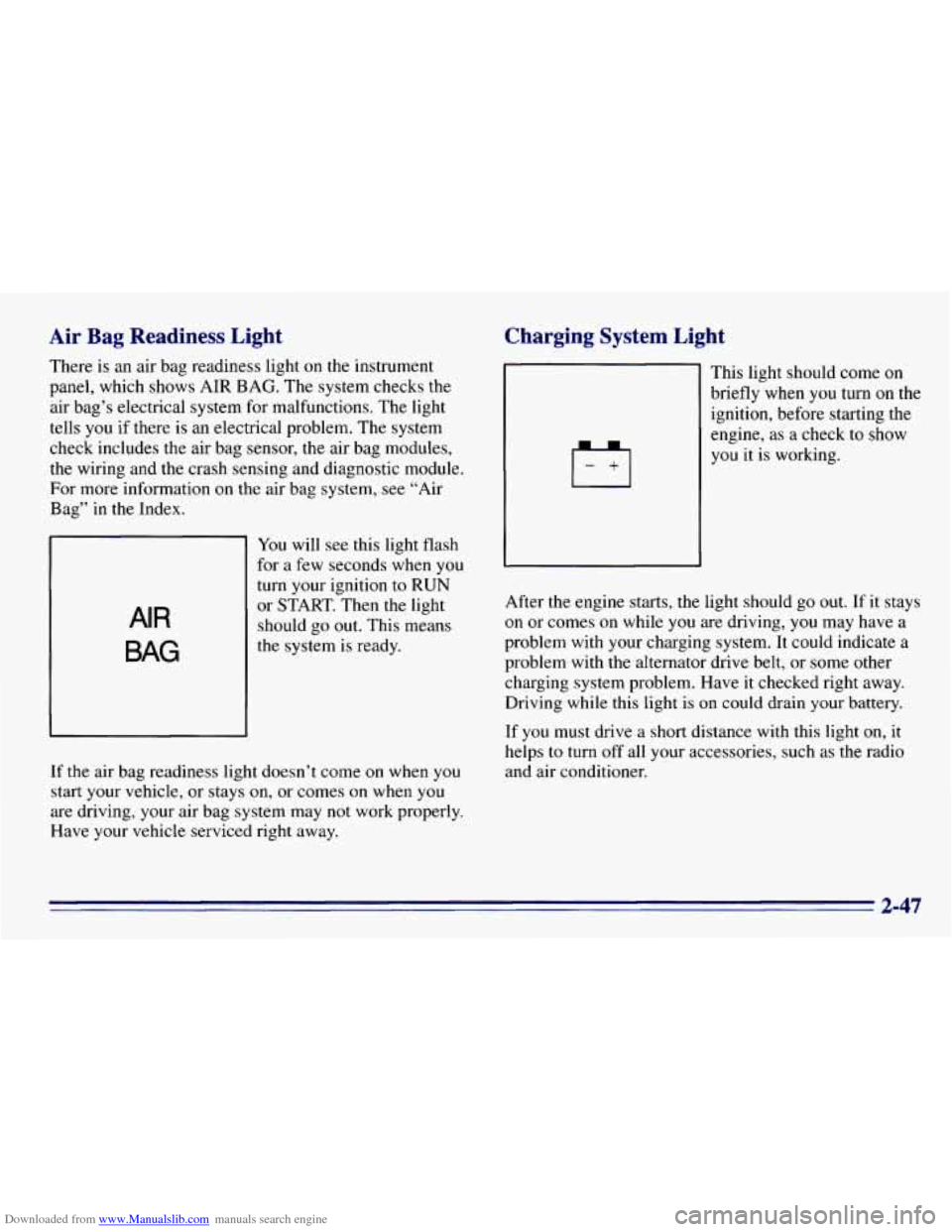
Downloaded from www.Manualslib.com manuals search engine Air Bag Readiness Light
There is an air bag readiness light on the instrument
panel, which shows AIR BAG. The system checks the
air bag’s electrical system for malfunctions. The light
tells
you if there is an electrical problem. The system
check includes the air bag sensor, the air bag modules,
the wiring and the crash sensing and diagnostic module.
For more information
on the air bag system, see “Air
Bag” in
the Index.
AIR
BAG
You will see this light flash
for a few seconds when you
turn your ignition to
RUN
or START. Then the light
should go
out. This means
the system is ready.
If the air bag readiness light doesn’t come on when you
start your vehicle, or stays on, or comes on when you
are driving, your air bag system may not work properly.
Have your vehicle serviced right away.
Charging System Light
This light should come on
briefly when you turn on the
ignition, before starting the
engine, as a check to show
you
it is working.
After the engine starts, the light should go out. If it stays
on or comes on while you are driving, you may have a
problem with your charging system. It could indicate a
problem with the alternator drive belt, or some other
charging system problem. Have it checked right away.
Driving while this light is on could drain your battery.
If you must drive a short distance with this light
on, it
helps
to turn off all your accessories, such as the radio
and air conditioner.
2-47
Page 110 of 376
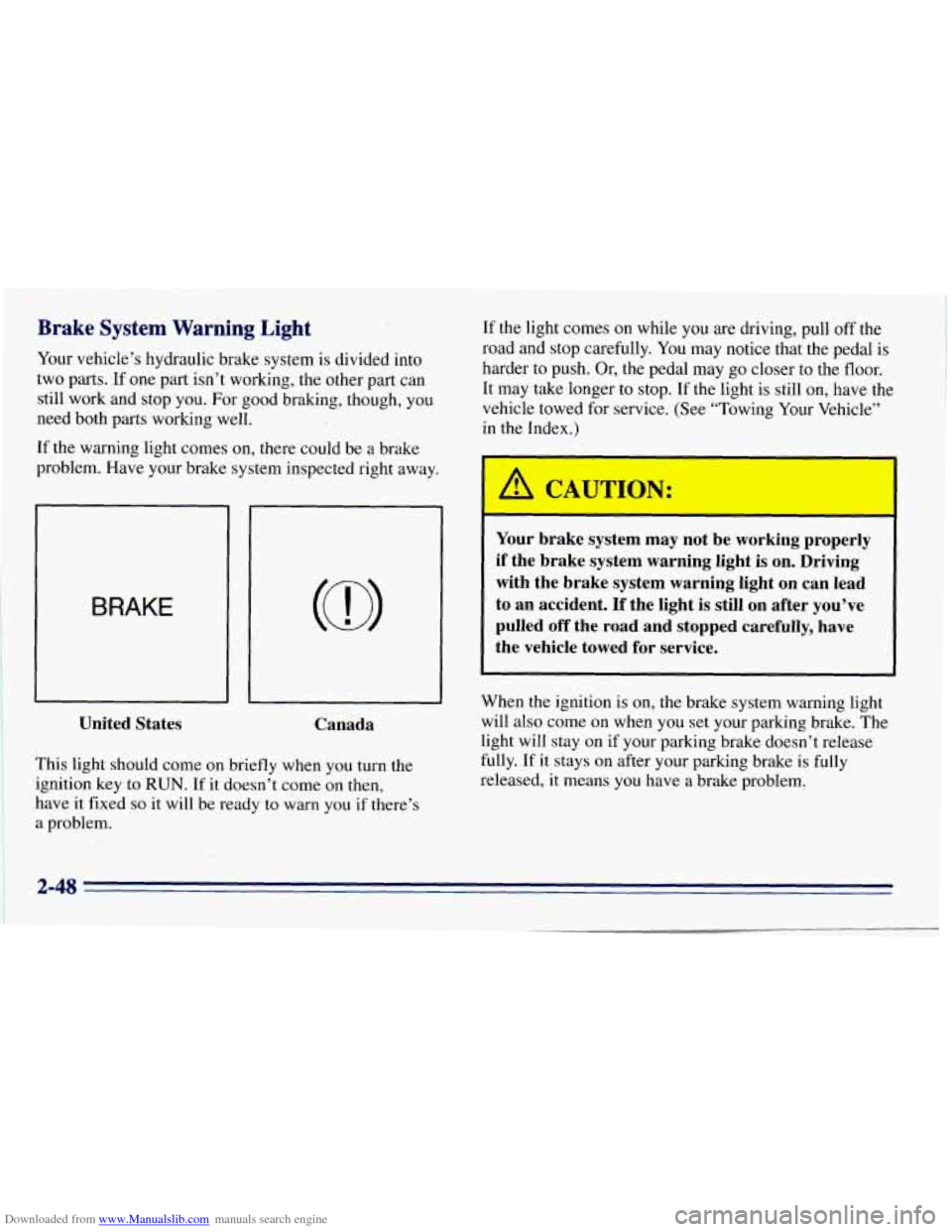
Downloaded from www.Manualslib.com manuals search engine Brake System Warning Light
Your vehicle’s hydraulic brake system is divided into
two parts.
If one part isn’t working, the other part can
still work and stop
you. For good braking, though, you
need both parts working well.
If the warning light comes on, there could be a brake
problem. Have your brake system inspected right away.
BRAKE
United States
Canada
This light should come on briefly when you turn the
ignition key
to RUN. If it doesn’t come on then,
have it fixed
so it will be ready to warn you if there’s
a problem. If
the light comes on while you are driving, pull off the
road and stop carefully. You may notice that the pedal
is
harder to push. Or, the pedal may go closer to the floor.
It may take longer
to stop. If the light is still on, have the
vehicle towed for service. (See “Towing Your Vehicle”
in the Index.)
Your brake system may not be working properly
if the brake system warning light is on. Driving
with the brake system warning light on can lead
to an accident. If the light is still on after you’ve
pulled off the road and stopped carefully, have
the vehicle towed for service.
When the ignition is on, the brake system warning light
will also coke on when you set your parking brake. The
light will stay on if your parking brake doesn’t release
fully. If it stays on after your parking brake is fully
released,
it means you have a brake problem.
2-48